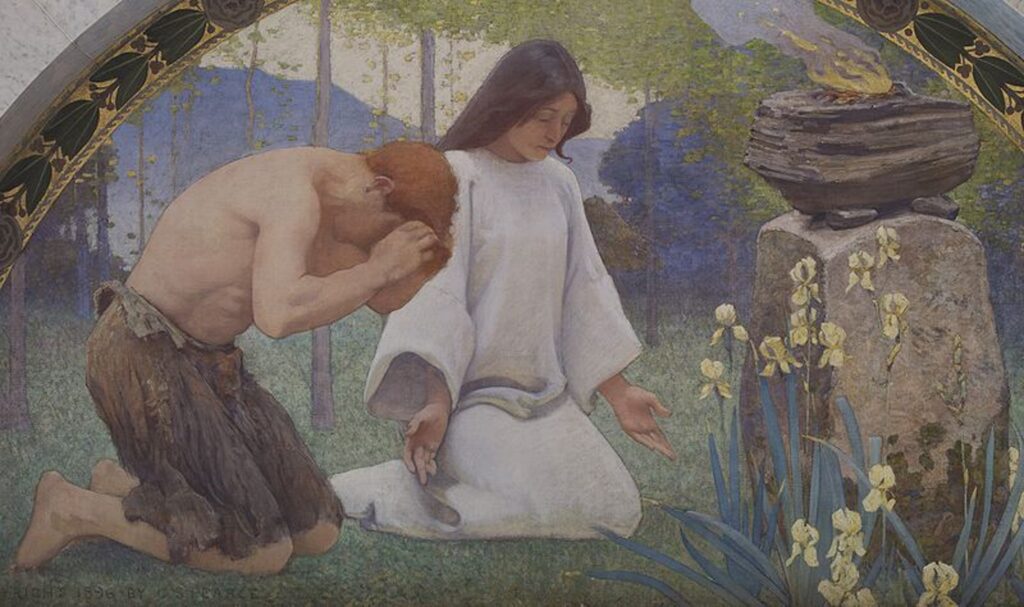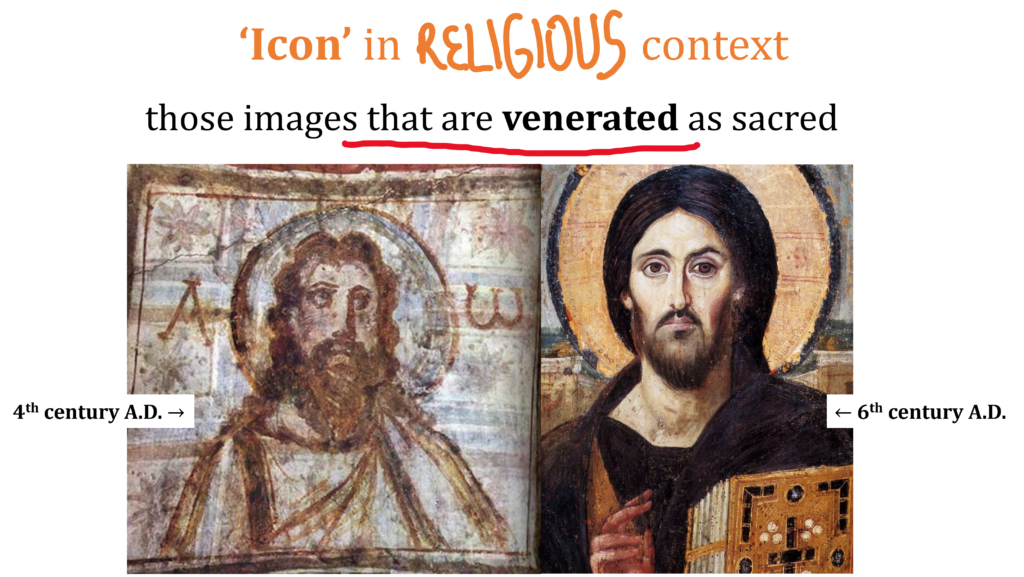The words covered in this article are secular, veneration, reverence and irreverence, proscribe and proscription, connotation, and idolatry. A previously done word that will reoccur today is ambiguity.
Look at your phone. You have probably downloaded a few apps on it. What do you call the blobs on your phone screen that you click on to go to apps like Facebook or Gmail?
ICONS.
We use the word ‘icon’ quite often these days, but I want you to take a moment to think how you will define this word.
If the blue blob on your phone screen is an icon of Facebook, then we can define icon as an image that symbolizes something. In the context of smartphone apps, this ‘something’ is usually an app.
The origin of the word also supports this meaning. ‘Icon’ is simply the English rendering of the Greek word eikon, which means ‘image.’
The world of social networking apps uses another word derived from ‘icon’ – emoticon, which is formed by combining the words ‘emotion’ and ‘icon.’ So, an emoticon is an image that symbolizes an emotion.
Going back to the definition of ‘icon’ – an image that symbolizes something – the ‘something’ that an ‘icon’ symbolizes could also be an abstract thing like a belief or a way of life. For example,
- The Statue of Liberty is an icon of freedom and hope.
- Meaning: this physical statue represents – is a symbol of – freedom and hope.
- The paper cup is an icon of our modern throwaway culture.
- So, the paper cup represents (symbolizes) our lack of guilt over making and consuming things that will be used only once.
So far, we have learnt two contexts in which the word ‘icon’ is used:
- Smartphones
- Beliefs, ways of life
Both these contexts are ‘secular.’
Secular
Secular means not religious.
Secular music is music that has non-religious themes or uses; for example, songs about love or heartbreak. Secular music contrasts with sacred music (also called ‘religious music’), which is music that has religious themes or uses. The hymns sung in a church or a temple are an example of sacred music.
Secularism is the belief that religion should be kept out of social and political matters.
Returning to the word icon, it is used in not only secular but also religious contexts.

In religion, ‘icon’ denotes such paintings or other representations of divine figures, saints, angels, or scenes or themes from holy books that are venerated as sacred.
Veneration-Reverence
The nouns veneration and reverence are exact synonyms. Both mean great respect.

Imagine a Respect Scale, on which you can plot the amount of respect you have for a person or thing. Veneration and reverence will mark the uppermost end of this scale (the max amount of respect), while ‘Insult’ will mark the lower end. We may respect a lot of people (say, our parents, kind old relatives, or teachers who had a formative influence on us), but when we venerate or revere a person, it means that we hold him or her in the highest regard possible.

The painting above shows a couple venerating a stone god.
The image below shows two icons of Jesus Christ, one that dates back to the 4th century and the other that is from the 6th century. To devout Christians they are no ordinary drawings but the physical representations – the symbols – of Jesus Christ, the Son of God. Think of how we tend to show our love or respect for a person through physical gestures such as holding their hand, kissing them or bowing before them. In the same way, people tend to show love and reverence for gods and long-dead holy figures by kissing their representations or bowing before them. The images that are venerated thus are the ones that get called ‘icons.’

Not every representation of a religious subject is an icon. For example, if some irreverent cartoonist draws a cartoon of Jesus Christ or Prophet Mohammed or Lord Ram, no one will even consider bowing before that image. Therefore, such a cartoon is not an icon. Only those representations of a religious subject are called icons that are deemed to be sacred and worthy of veneration.
Note also that I called the cartoonist irreverent. If reverence is deep respect then, who is an irreverent person? Someone who does not show proper respect. The cartoonist chose to make fun of those men whom most people worship. So, the worshippers are going to call him irreverent because he did not show proper respect for their holy men.
Like beauty, irreverence lies in the eyes of the beholder. As Mark Twain is quoted to have said:
I was never consciously and purposely irreverent in my life, yet one person or another is always charging me with a lack of reverence. Reverence for what — for whom? Who is to decide what ought to command my reverence — my neighbor or I? I think I ought to do the electing myself.
Mark Twain: A Biography (1912), by Albert Bigelow Paine
I should also note that some people use the word ‘icon’ strictly for two-dimensional representations of divine figures or themes, while other people extend the use of ‘icon’ to include 3-dimensional representations, like statues or metal or wooden figurines.
Many religions make use of icons in their practices of worship. Think about the places of worship in your own religion: are there images, statues or other symbols which you bow or light candles before, which you kiss or revere in other ways?
- If you say ‘yes’, then your religion allows or encourages the use of icons to worship God. The reverence of icons is a common practice of many traditional religions in Asia, ancient Egypt, Greece, Rome, Africa, the Americas and elsewhere.
However, there are many aniconic religions too (an- + iconic). Aniconic religions are those that proscribe the use of icons in worship.
Proscribe
The verb proscribe means to ban. The noun form of this word is proscription.
Islam is an example of an aniconic religion. It proscribes images of God and of prophet Mohammad. This means, Muslims are absolutely forbidden to draw an image of God or of Prophet Mohammad. Even the images of humans and animals are discouraged. This is why Islamic art is dominated by geometric patterns and calligraphy and hardly features human or animal figures.
Now is a good time to introduce the word ‘idol.’
An idol is an image or object that people worship as part of their religion.
Compare this definition with the religious meaning of the word ‘icon.’ You’ll find that the words ‘idol’ and ‘icon’ have identical meanings. However, the two words are usually not used interchangeably, because the word ‘idol’ sometimes has a negative connotation.
Connotation
The noun connotation means an idea or association conveyed by a word in addition to its literal meaning.
For example, the literary meaning of the words ‘abnormal’ and ‘extraordinary’ is the same: unusual. But the words are seldom used interchangeably as ‘abnormal’ has a negative connotation while ‘extraordinary’ has a positive connotation. To call someone ‘extraordinary’ is to praise them for being wonderfully unlike the common folks, but to call someone ‘abnormal’ is to say that they fare worse than most people on some metric.
While the words ‘idol’ and ‘icon’ have the same literal meaning in the religious context, they have different connotations.
Verb form: to connote.
Idolatry
Idolatry means religious worship of idols.
But then, what exactly do we mean by ‘worship’? If you look up its dictionary meaning, you see two definitions:
- Reverence
- Reverent love and devotion, adoration.
So, the word ‘worship’ is an ambiguous word – it actually includes within its scope two distinct emotional states: reverence and the deeper, greater emotion of reverent love. Therefore, some people clarify what they mean by ‘worship’ by adding ‘of veneration’ or ‘of adoration’ to it.
- ‘Worship of veneration’ maps to the first dictionary definition listed above, while
- ‘Worship of adoration’ maps to the second one.

We will continue this discussion tomorrow. Here are some more usage examples for the words you’ve learnt today:
- “What does it mean to say that the Western world today lives in a secular age? Whereas the political organization of all pre-modern societies was in some way connected to, based on, guaranteed by some faith in, or adherence to God, or some notion of ultimate reality, the modern Western state is free from this connection . . . Religion or its absence is largely a private matter.” Excerpted from The Secular Age, by Charles Taylor.
- “[English] vocabulary boomed in the sixteenth century, and many . . . new words were borrowed from Latin, Italian, and French. . . By the end of the century the language was growing so quickly . . . that a handful of native speakers stepped in to provide order. In 1586, William Bullokar, a man who was interested in regularizing and reforming English, published the first English grammar; in 1604, Robert Cawdrey published what is held to be the first monolingual English dictionary. The concern was that English was becoming terribly unruly, and it needed some reining in. Some called for a large-scale remedy—an academy of English that would not only prescribe good usage but proscribe bad stuff [such as inelegant words, styles, uses etc.] out of English.” Adapted from a passage in Word by Word, by Kory Stamper
- No one is neutral about Marshal Philippe Petain. He either excites great veneration or great contempt.
- JK’s comment: The adjective ‘great’ is actually redundant (i.e. extra, unneeded) in this usage example, because veneration itself means great respect. Also, if you juxtapose this sentence with the Respect Scale mentioned above, you’ll note that the word ‘contempt’ is intended to be placed at the lower end (minima) of the Respect Scale.